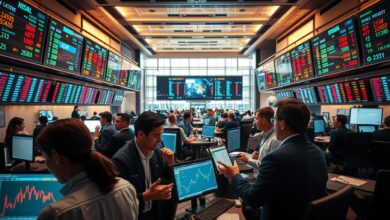Investment Options in Renewable Energy
The world is shifting towards cleaner energy, and investment options in renewable energy are growing. These investments focus on using sustainable energy sources. They are becoming more appealing to both individuals and big investors.
In South Africa, the renewable energy sector is changing fast. New technologies have made solar and wind power much cheaper. Costs have dropped by 83% and 85% since 2010.
The need for renewable energy is increasing. The U.S. is expected to see a 6% rise in renewable energy use by 2050. Investing in solar, wind, and other green sources can offer big returns. It also helps fight climate change worldwide.
Government support and the shift to cleaner energy make renewable investments attractive. They offer a chance to make money and help the planet. Exploring these options shows a commitment to a greener future. It’s an exciting time for those wanting to invest in green energy.
Understanding Renewable Energy Fundamentals
Renewable energy uses different resources to make sustainable power. Knowing about Renewable Energy Fundamentals helps us see how these resources make our future cleaner. The main types are solar, wind, and hydropower. Each one is key for making electricity, keeping the environment healthy, and helping the economy.
What Constitutes Renewable Energy?
Renewable energy includes various forms that use natural resources:
- Solar Energy: Photovoltaic systems are getting cheaper and more efficient.
- Wind Energy: Onshore wind farms are often more cost-effective than offshore ones.
- Hydropower: Large hydroelectric dams need big investments but provide steady energy for years.
- Biomass and Bioenergy: Places with lots of organic waste can use solid biomass energy.
- Geothermal Energy: This technology uses the Earth’s heat, offering a steady energy source.
- Ocean Energy: Tidal power is known for its stable and predictable energy generation.
The Importance of Renewable Energy in the Global Economy
Renewable energy is more than good for the environment. It also boosts the economy by creating jobs and driving innovation. As prices drop, renewable tech becomes more competitive, attracting investors. Recently, global investments in renewable energy hit over 300 billion euros, showing its importance.
Also, governments with good policies, like feed-in tariffs, help projects succeed. This makes the market more stable and attractive for developers.
Market Evolution of Renewable Energy
The renewable energy sector has grown a lot in recent years. This growth shows we’re all moving towards sustainable energy. Technology plays a big role in this change.
Recent Trends in Renewable Energy Investment
In 2022, investment in renewable energy hit USD 495 billion. A big change happened in 2015 when renewables beat fossil fuels for electricity. Solar PV led with 62% of all investment, while wind power saw a small drop.
- Solar PV investment rose to USD 307.5 billion in 2022.
- Wind power got USD 174.5 billion, down 1.3% from last year.
- China led with 55% of global investment in 2022.
- Europe’s investment fell by 26% to USD 55.9 billion.
Impact of Technology on Costs
Technology has made a huge difference, making renewables competitive with traditional energy. New wind farms are now cheaper than keeping old coal plants running. Solar and wind costs have dropped by 83% and 85% since 2010, respectively.
This has helped renewables grow fast. They’re expected to cover 40% of energy growth in the next five years.
Investment Options in Renewable Energy
The renewable energy sector has grown a lot, offering many Investment Options in Renewable Energy for investors. These options let investors get involved in a promising field. They also offer a chance for sustainable returns.
Types of Renewable Energy Investments
Investors can look into several types of investments in renewable energy. These include:
- Direct investments in renewable energy projects, such as solar farms and wind installations.
- Purchasing stocks in leading renewable energy companies like Shell, Google, and Amazon.
- Engaging through specialized investment funds or exchange-traded funds (ETFs) that track indices like the S&P Global Clean Energy index.
Each option offers unique chances and exposure to the growing renewable energy market. This market saw over $200 billion in investments for the ninth year in a row.
Benefits of Investing in Renewable Energy
The Benefits of Investing in renewable energy are big. They include:
- Portfolio diversification that reduces risk.
- Potential for cash yield linked to inflation, ensuring that returns keep pace with rising costs.
- A growing trend in corporate Power Purchase Agreements (PPAs), showing strong support from big companies.
- Long-term contracted cashflows associated with renewable energy assets, often correlating with creditworthy counterparts.
Renewable energy portfolios have done better than fossil fuel portfolios over ten years. They have returned 192.3% compared to 97.2%. As this sector grows, investors can look forward to more income and growth opportunities.
Government Policies and Support
Government policies play a big role in the growth of renewable energy projects. In South Africa, these policies help move from coal to cleaner energy. This change affects the economy and the environment.
Initiatives like tax credits and rebates make renewable technologies more accessible. This helps investors put money into this sector.
The Role of Government Incentives
Government incentives are key in pushing renewable energy forward. South Africa’s plan is to add 29,500MW of electricity by 2030. This will include a lot of wind and solar energy.
The government also plans to add 11,813MW of power to solve electricity shortages. Solar energy will lead this effort, with 8.7GW of capacity planned for 2023 to 2032.
- Tax credits and rebates encourage investments.
- Support for large-scale renewable projects enhances energy production.
- Investment in human capacity building promotes socio-economic development.
Pursuing the Goals of the Paris Agreement
South Africa’s energy policy aligns with the Paris Agreement Goals. The government aims to cut carbon emissions. It plans to close over 10,000MW of coal plants by 2030.
This change is crucial since coal makes up 80% of the country’s energy. By 2032, non-hydro renewable sources will grow from 9.3% to 17.0%. This move towards cleaner energy is significant.
Government policies also focus on rural areas with mini-grids and hybrid systems. These efforts meet energy needs and tackle poverty and health issues. This shows strong support from the government for renewable energy.
Renewable Energy Stocks to Watch
The renewable energy sector is growing fast, offering many investment chances. Investors should look at stocks from top companies in solar, wind, and hydroelectric power. Knowing these stocks can help make smart investment choices.
Top Companies Leading the Charge
Many companies are leading in renewable energy, with big market values and growth potential:
- NextEra Energy: It’s one of the biggest in the US, with a market cap of $139.7 billion.
- First Solar: Known for solar panels, it has a market cap of $18.8 billion and plans to increase production.
- Brookfield Renewable: Worth $5.8 billion, it has grown its dividend payments by 6% every year since 2001.
- Clearway Energy: With a $2.6 billion market cap, it aims to grow its renewable energy and predict dividend growth until 2026.
- SolarEdge Technologies: Valued at $3.4 billion, it’s expanding through acquisitions and had almost $900 million in cash at the end of 2023.
Performance Analysis of Renewable Energy Stocks
Renewable energy stocks tend to be less volatile than traditional energy stocks. The sector has quadrupled its electricity-generating capacity in the last decade. This growth makes these stocks appealing for long-term investors.
The global economy is moving towards decarbonization, with over $150 trillion expected to be invested in the next three decades. This investment will boost the sector’s growth potential.
Legislative support, like the Inflation Reduction Act, has also played a big role. It allocated $369 billion for energy security and climate change. Knowing these factors can help investors make better choices in the renewable energy market.
Exploring Renewable Energy Investment Funds
Renewable Energy Investment Funds are a great way for investors to get into the clean energy market. These funds offer a range of choices for different risk levels and investment plans. From solar projects to a mix of clean technologies, investors can find the right fit. This helps them make money while supporting the planet.
Diverse Options Available for Investors
Investors have many choices in Renewable Energy Investment Funds. These include:
- Equity Funds: Direct investments in companies that make renewable energy.
- Debt Funds: Investments in green bonds or loans for renewable energy projects.
- Exchange-Traded Funds (ETFs): Tradeable funds that invest in many renewable energy companies.
- Private Equity: Direct investment in companies or projects for big returns.
Each option has its own benefits. They help investors meet their sustainability goals and support the energy shift.
How to Select the Right Fund
Choosing the right fund is important. It should match your goals and risk level. Key things to look at include:
- Performance History: Check how well funds have done over time.
- Management Expertise: Look at the managers’ experience and reputation in renewable energy.
- Sustainability Alignment: Make sure the fund’s goals match your sustainability goals.
Investing in renewable energy needs a smart plan. By making informed choices, investors can make a difference and earn well. This supports a sustainable energy future.
Green Energy Investment Opportunities
The world is moving towards sustainable energy, leading to a rise in Green Energy Investment Opportunities. This is especially true in Emerging Markets. These areas have a lot of potential for growth in clean technology, thanks to growing demand for eco-friendly solutions and efforts to cut carbon emissions.
Emerging Markets in Clean Technology
Investors looking to grow clean technologies find a unique opportunity in Emerging Markets. Africa, for example, urgently needs sustainable energy infrastructure. With Africa’s population expected to double by 2050, the need for reliable energy will grow even more.
About 600 million people in Africa lack electricity access. By 2050, this number could reach 1.2 billion. This creates a big market for renewable energy solutions.
- Solar energy is set to contribute around 70 percent of Africa’s installed energy capacity by 2050.
- Wind energy, projected at 20 percent, shows how diverse renewable sources can meet the continent’s energy demands.
- Hydroelectric power will account for approximately 10 percent, demonstrating the value of established technologies.
The move towards greener technologies could limit energy consumption growth in Africa to just 50 percent by 2050. This opens up many opportunities in the global renewable energy market.
Private vs Public Investment Options
Investors have different choices for green ventures. Private investments often offer higher returns because they carry more risk. They let investors directly support projects like wind and solar or innovative water management, which can have big impacts in Emerging Markets.
Public investments, on the other hand, are more stable and less risky. They include government-backed projects aimed at boosting renewable energy. For example, the growing interest in environmental consulting shows a surge in investment in compliance and sustainability, helping companies meet stricter environmental rules.
Both private and public investments are key to the shift to clean energy and fighting climate change. As the world focuses more on sustainability, aligning these investments will be vital to fund the massive projects needed for the transition.
Evaluating Risks in Renewable Energy Investments
Investing in renewable energy can be promising, but it comes with risks. It’s important to understand market risks that can affect the success of renewable projects. Energy price volatility is a big concern, caused by demand changes, regulations, or seasonal shifts.
Investors also need to watch out for technological risks. Relying on new technologies can lead to problems if better, cheaper options come along.
Market Risks Associated with Clean Energy
Market risks in clean energy can greatly impact investments. For example, policy changes can affect investment stability. Spain’s move to a new support scheme in 2021 shows how important it is to keep up with changes.
Understanding daily, quarterly, and yearly energy generation variations is key for long-term planning. This helps investors make better financial decisions.
Technological and Political Risks
Technological and political risks add complexity to renewable energy investments. Securing funding and ensuring project success can be tough. Delays and the need for thorough checks are common challenges.
Social acceptance in communities is also crucial. It can make or break a project. Investors must stay alert to market, political, and regulatory changes. This ensures their investments in renewable energy are strong.
FAQ
What are the main forms of renewable energy?
How has the investment landscape evolved in renewable energy?
What types of renewable energy investments are available?
What benefits come from investing in renewable energy?
How do government policies affect renewable energy investments?
Which renewable energy stocks should investors keep an eye on?
What are the options for renewable energy investment funds?
What emerging markets present opportunities in clean technology?
What risks should investors consider in renewable energy?
Published on: 17 de July de 2024

Bakari Romano
Bakari Romano is a finance and investment expert with a strong background in administration. As a dedicated professional, Bakari is passionate about sharing his knowledge to empower individuals in managing their finances effectively. Driven by this mission, he founded FinancasPro.com, where he provides insightful and practical advice to help people make informed financial decisions. Through his work on the site, Bakari continues to make finance accessible and understandable, bridging the gap between expert knowledge and everyday financial needs.






